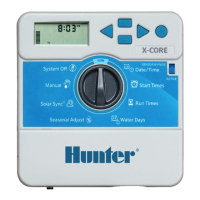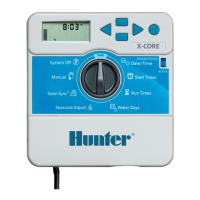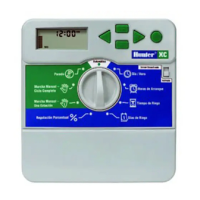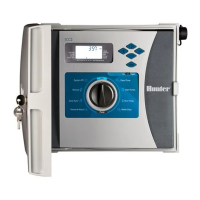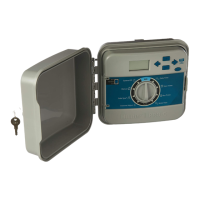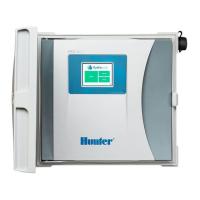SPECIFICATIONS
Operating Specications
• Station Run Time: 1 minute to 12 hours (in 1-minute increments) on programs A, B, C, D.
• Start Times: 8 per day, per program (A, B, C), 16 per day (D), for up to 40 daily starts.
• Watering Schedule: 7-day calendar, interval watering up to a 31-day interval or true odd or even day programming, made possible by the 365-day
clock/calendar.
Electrical Specications
• Transformer Input: 120 VAC, 60Hz (230 VAC, 50/60 Hz International Use)
• Transformer Output: 25 VAC, 1.5 amp
• Station Output: 24VAC, 0.56 amps per station
• Maximum Output: 24VAC, 1.4 amps (includes Master Valve Circuit)
• Battery Backup: 9-volt alkaline battery (not included) used only for time keeping during power outages, the nonvolatile memory maintains program
information.
Dimensions
• Plastic Cabinet
Height: 11" (28 cm)
Width: 12" (30.5 cm)
Depth: 3¾" (9.5 cm)
• Metal/Stainless Cabinet
Height: 15¾" (40 cm)
Width: 11
3
/8" (29 cm)
Depth: 4½" (11.4 cm)
• Plastic Pedestal
Height: 38" (96 cm)
Width: 20 ½" (52 cm)
Depth: 15" (38 cm)
Default Settings
All stations are set to zero run time. This controller has a non-volatile memory that retains all entered program data even during power outages, without
need for a battery.
FCC NOTICE
This controller generates radio frequency energy and may cause interference to radio and television reception. It has been type tested and found to comply
with the limits for a Class B computing device in accordance with the specications in Subpart J of Part 15 of FCC Rules, which are designed to provide
reasonable protection against such interference in a residential installation. However, there is no guarantee that interference will not occur in a particular
installation. If this equipment does cause interference to radio or television reception, which can be determined by turning the equipment off and on, the
user is encouraged to try to correct the interference by one or more of the following measures:
• Reorient the receiving antenna.
• Move the controller away from the receiver.
• Plug the controller into a different outlet so that controller and receiver are on different branch circuits.
If necessary, the user should consult the dealer or an experienced radio/television technician for additional suggestions. The user may nd the following
booklet prepared by the Federal Communications Commission helpful: “How to Identify and Resolve Radio-TV Interference Problems.” This booklet is
available from the U.S. Government Printing Ofce, Washington, D.C., Stock No. 004-000-00345-4 (price – $2.00 postpaid).
39
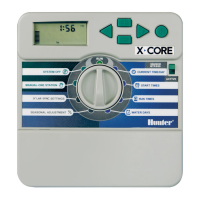
